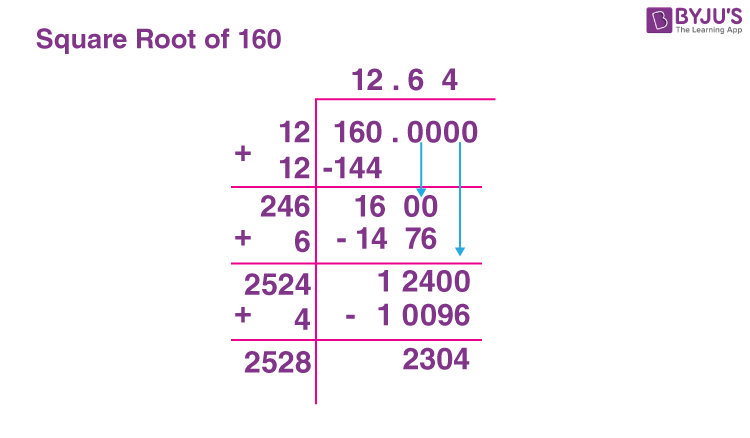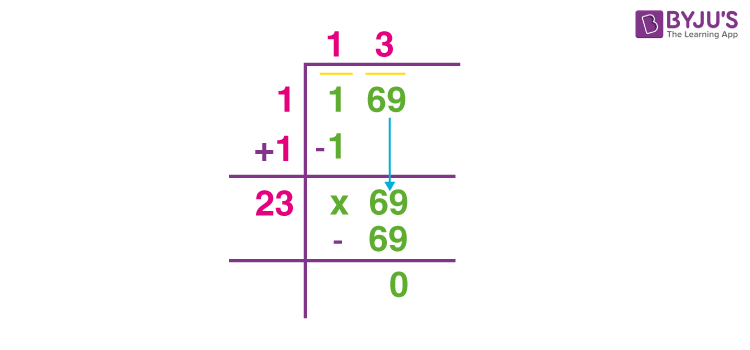Topic square root of 162 simplified: The square root of 162 simplified is a fundamental concept in mathematics that involves breaking down the number into its simplest radical form. This article provides a detailed explanation and step-by-step guide to simplify √162, making it easy for students and enthusiasts to understand and apply the concept effectively.
Table of Content
Simplifying the Square Root of 162
The square root of 162 can be simplified to its simplest radical form. Here's a detailed breakdown of the process:
Steps to Simplify √162
- List the factors of 162:
- 1, 2, 3, 6, 9, 18, 27, 54, 81, 162
- Identify the perfect squares from the list of factors:
- 1, 9, 81
- Divide 162 by the largest perfect square:
- 162 / 81 = 2
- Calculate the square root of the largest perfect square:
- √81 = 9
- Combine the results to get the simplified form:
- √162 = 9√2
Thus, the simplified form of the square root of 162 is \( 9\sqrt{2} \).
Decimal Form
The decimal form of the square root of 162 is approximately:
√162 ≈ 12.72792
Exponent Form
The square root of 162 can also be expressed using exponents:
√162 = 1621/2 = 9 * 21/2
Rational or Irrational?
Since 162 is not a perfect square, its square root is an irrational number. This means it cannot be expressed as a simple fraction.
Long Division Method
You can also calculate the square root of 162 using the long division method:
| 1 | 62 | 00 |
| 1 | ||
| 1 | 62 | |
| 00 |
The final result of the long division method is approximately:
√162 ≈ 12.7279
Important Notes
- The number 162 is not a perfect square.
- The square root of 162 is an irrational number.
- The square root of -162 is an imaginary number, written as ±12.7279i.
By following these steps, you can simplify and understand the square root of 162 in various forms.

READ MORE:
Introduction
The square root of 162, often represented as √162, is a fascinating mathematical concept that reveals the inner workings of numbers. Simplifying the square root of 162 involves breaking down the number into its prime factors and expressing it in its simplest radical form. This process not only helps in understanding the properties of 162 but also illustrates fundamental principles of mathematics.
To simplify √162, we start by performing prime factorization. The prime factors of 162 are 2 and 3, which can be grouped as follows:
162 = 2 × 3 × 3 × 3 × 3 = 2 × 34.
Next, we apply the product rule for radicals to simplify this expression:
√162 = √(2 × 34) = √2 × √(34).
Since the square root of 34 is 9 (because √(34) = 32 = 9), we can further simplify this to:
√162 = 9√2.
Therefore, the simplified form of the square root of 162 is 9√2. In decimal form, this value is approximately 12.7279.
Understanding the simplification of square roots is crucial in various mathematical applications, including solving equations, analyzing geometric properties, and more. The process highlights the elegance and structure inherent in mathematics.
Mathematical Definition
The square root of 162, denoted as √162, involves finding a number that, when multiplied by itself, gives the product 162. This process can be understood through various methods such as factorization and the use of perfect squares.
Here's a step-by-step guide to simplifying √162:
- List the factors of 162: 1, 2, 3, 6, 9, 18, 27, 54, 81, 162.
- Identify the perfect squares in the list: 1, 9, 81.
- Choose the largest perfect square: 81.
- Divide 162 by 81 to get: 162 / 81 = 2.
- Calculate the square root of 81: √81 = 9.
- Combine these results: √162 = 9√2.
In exponential form, this is represented as (162)^(1/2) = 9 * (2)^(1/2), and in decimal form, it is approximately 12.7279.
This method illustrates the importance of understanding factors and perfect squares in simplifying square roots efficiently.
Perfect Squares and Simplification
To simplify the square root of 162, follow these steps:
- List Factors: List the factors of 162: 1, 2, 3, 6, 9, 18, 27, 54, 81, 162.
- Identify Perfect Squares: From the list of factors, identify the perfect squares: 1, 9, 81.
- Divide by the Largest Perfect Square: Divide 162 by the largest perfect square identified, which is 81. Thus, \( 162 \div 81 = 2 \).
- Calculate the Square Root: Calculate the square root of the largest perfect square: \( \sqrt{81} = 9 \).
- Simplify: Combine the results to get the simplest radical form: \[ \sqrt{162} = \sqrt{81 \times 2} = \sqrt{81} \times \sqrt{2} = 9\sqrt{2} \].
Hence, the square root of 162 simplified is \( 9\sqrt{2} \).
| Exact Form | \( 9\sqrt{2} \) |
| Decimal Form | Approximately 12.72792 |
Calculation Methods
Calculating the square root of 162 can be approached through several methods. Here, we explore both the prime factorization method and the long division method, which are commonly used to simplify and accurately determine the square root of non-perfect squares like 162.
Prime Factorization Method
- Factorize 162: List the factors of 162: 1, 2, 3, 6, 9, 18, 27, 54, 81, 162.
- Identify Perfect Squares: From these factors, identify the perfect squares: 1, 9, 81.
- Divide by Largest Perfect Square: Divide 162 by the largest perfect square: 162 / 81 = 2.
- Calculate the Square Root: Compute the square root of the perfect square: √81 = 9.
- Combine Results: The simplified form is obtained by multiplying the square root of the perfect square by the square root of the quotient: 9√2.
Thus, the square root of 162 in its simplest radical form is 9√2.
Long Division Method
- Pair the Digits: Group the digits of 162 in pairs from the decimal point: (1)(62).
- Find Initial Quotient: Find the largest number whose square is less than or equal to 1. Here, it is 1 because 1×1=1.
- Set New Divisor: Double the initial quotient and set it as the new divisor. For the next steps, the new divisor is 2.
- Bring Down Next Pair: Bring down the next pair (62) making it 62.
- Find Next Digit: Find a digit (m) such that (2m)×m ≤ 62. Here, m=2 because 22×2=44 ≤ 62.
- Continue Division: Continue the process by bringing down pairs of zeros and repeating the steps until the desired precision is achieved.
The square root of 162 calculated using the long division method is approximately 12.72792.
Summary
By using these methods, we see that the square root of 162 can be expressed both in its simplest radical form as 9√2 and in decimal form as approximately 12.728.

Rational or Irrational
The square root of 162 is an interesting example to explore the concept of rational and irrational numbers. To determine if √162 is rational or irrational, we need to understand the definitions and properties of these types of numbers.
- Rational Numbers:
Rational numbers are numbers that can be expressed as a fraction where both the numerator and the denominator are integers, and the denominator is not zero. Examples include 1/2, 3/4, and 7.
- Irrational Numbers:
Irrational numbers cannot be expressed as a simple fraction. They have non-terminating and non-repeating decimal expansions. Examples include π (pi), e (Euler's number), and √2.
To determine if √162 is rational or irrational, we need to see if it can be expressed as a fraction of two integers. Since 162 is not a perfect square, its square root cannot be simplified to a whole number.
Let's break it down:
- The prime factorization of 162 is 2 × 34.
- The square root of 162 can be simplified using its prime factors: √(2 × 34) = √(2 × 81) = √2 × √81 = √2 × 9 = 9√2.
Since √2 is an irrational number (as it cannot be expressed as a fraction), multiplying it by 9 (a rational number) still results in an irrational number.
Therefore, √162 is irrational because it cannot be expressed as a fraction of two integers. Its decimal form is non-terminating and non-repeating, further confirming its irrational nature.
In summary:
- √162 = 9√2
- √2 is irrational
- Thus, 9√2 is also irrational
Exponential Form
The square root of 162 can be represented in exponential form using fractional exponents. This is an alternative way of expressing roots that can be particularly useful in various mathematical contexts.
The general form of a square root expressed with exponents is:
- \(\sqrt{b} = b^{1/2}\)
Applying this to 162, we have:
- \(\sqrt{162} = 162^{1/2}\)
We can also simplify the square root of 162 by factoring out the perfect squares:
- \(\sqrt{162} = \sqrt{81 \times 2} = \sqrt{81} \times \sqrt{2}\)
- Since \(\sqrt{81} = 9\), we get \(\sqrt{162} = 9\sqrt{2}\)
Expressing this simplified form in exponential notation, we get:
- \(\sqrt{162} = 9 \times 2^{1/2}\)
Therefore, the square root of 162 can be written as \(162^{1/2}\) or \(9 \times 2^{1/2}\) in exponential form, demonstrating the relationship between the base and its fractional exponent.
Visual Learning
Understanding the concept of square roots can be greatly enhanced through visual learning tools. Here are some effective methods to visually grasp the square root of 162:
1. Graphical Representation
A graphical approach involves plotting the function \(y = \sqrt{x}\) and identifying the point where \(x = 162\). This helps in visualizing how the square root function behaves and where the value of \(\sqrt{162}\) lies on the graph.
2. Geometric Interpretation
Using geometric shapes, such as squares, to represent numbers is a helpful method. For instance, you can draw a large square with an area of 162 square units and then visually break it down into smaller squares. By comparing it to smaller perfect squares, such as 81 (9x9), you can see that \(\sqrt{162}\) is slightly more than 9.
3. Interactive Tools
Interactive tools and online calculators can dynamically show the process of simplifying \(\sqrt{162}\). For example:
- Splitting 162 into 81 and 2: \(162 = 81 \times 2\)
- Simplifying using the property of square roots: \(\sqrt{162} = \sqrt{81 \times 2} = \sqrt{81} \times \sqrt{2} = 9\sqrt{2}\)
4. Visual Aids and Videos
Videos that illustrate the step-by-step process of finding the square root can be very beneficial. They often include animations that show the factorization and simplification processes, making it easier to understand the concepts.
5. Hands-On Activities
Engage in hands-on activities such as using physical objects or drawing on graph paper to find and approximate the square root of numbers. This tangible method can help reinforce the learning process.
6. Comparison with Perfect Squares
Another effective visual method is to compare \(\sqrt{162}\) with the square roots of nearby perfect squares (144 and 169). This helps in approximating the value of \(\sqrt{162}\) and understanding its position relative to other known values.
By employing these visual learning techniques, the concept of square roots, particularly the square root of 162, can be made much clearer and more intuitive.
Conclusion
The process of simplifying the square root of 162 not only provides a deeper understanding of radical expressions but also reinforces fundamental mathematical concepts. By recognizing that 162 is not a perfect square, we can simplify the expression √162 to 9√2. This simplification shows the importance of identifying perfect square factors and demonstrates how radicals can be broken down into simpler components.
Furthermore, the square root of 162, approximately equal to 12.7279 in decimal form, illustrates the concept of irrational numbers—those which cannot be expressed as simple fractions. Understanding the exponential form, 162^(1/2) or 9 * 2^(1/2), highlights the versatility of mathematical notation and its applications.
Overall, exploring the square root of 162 showcases the relationship between numbers, their properties, and different mathematical representations. Whether through visual learning aids, interactive tools, or traditional methods like long division, these approaches collectively enrich our comprehension and appreciation of mathematics.

Video hướng dẫn cách đơn giản hóa các căn bậc 4 của 162 và 48, giải thích chi tiết bằng tiếng Việt.
Radicals: Đơn giản hóa [4]√(162) * [4]√(48)
READ MORE:
Video hướng dẫn chi tiết cách tính và đơn giản hóa căn bậc hai của 162, giúp người xem hiểu rõ hơn về các bước tính toán.
Căn Bậc Hai của 162














